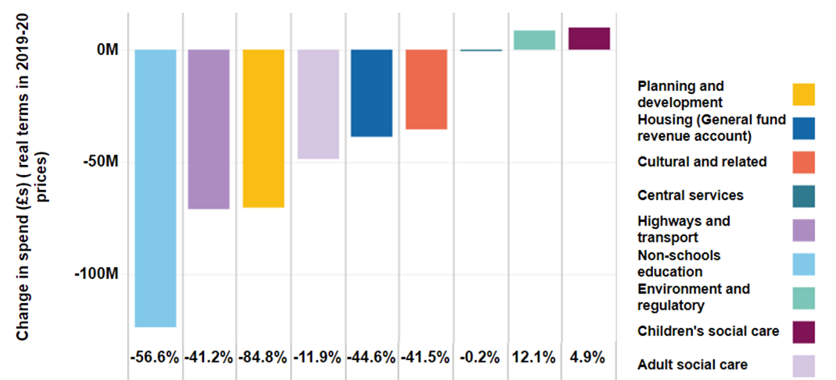Rebecca Riley and Abigail Taylor discusses the recent financial crisis to hit Birmingham City Council, and how the root of the issues facing this council and others around the UK, are a decade in the making.
This week it was announced that Birmingham City Council faces a spending freeze and greater scrutiny of its budget. An action plan has been announced to investigate the Council over its financial management in what councillors have branded “the biggest challenge the council has ever faced”.
Although the press are highlighting failures, it is important to recognise that Birmingham City Council has been battling historical and ongoing equal pay pressures, which needed to be funded from within Council budgets. These pressures are layered on top of the significant budget cuts that local authorities have been confronted with since the early 2010s.
The impact of funding reductions
Last year, City-REDI produced a report on the income and expenditure of BCC and how this changed over the period from 2010 – 2020. The report also explored budgetary pressures and their impact on decision-making.
Our analysis principally draws upon data from the 2021 National Audit Office (NAO) Financial Sustainability of Local Authorities Visualisation between 2010-11 and 2019-20 and Birmingham City Council’s Budgets for 2010/2011 and 2019/2020. The NAO data is presented in real terms in 2019-20 prices. Using real terms costs enables the effects of inflation to be considered. This is essential to demonstrate changes in the actual funding available to the Council over the decade studied.
Funding reductions have had significant impacts on local authorities in England since 2009/10. Fig 1 below illustrates where cuts to Birmingham City Council’s funding have occurred over the 10 years studied. Government funding has seen a significant decrease, due to austerity policies introduced by successive governments, which have slashed local authority budgets. Birmingham City Council alone had to make austerity cuts of £736 million. Overall, between 2010/2011 and 2019/20, the spending power of the Council decreased by 36.3% in real terms in 2019-20 prices.

Figure 2 below shows the change in service spend by Birmingham City Council in real terms.

In the longer term these cuts result in:
Service Cutbacks
All local authorities rely on funding to provide essential services such as education, social care, waste management, and transportation. When faced with funding reductions, local authority leaders may be forced to make cutbacks in these areas, resulting in reduced service quality or the cancelling of certain services altogether. As illustrated in Figure 1, non-schools education funding decreased by 56.6%, and Adult Social Care spending decreased by 11.9% over the 10-year period studied. Figure 2 shows how, in real terms, these cuts mean spending on non-schools education declined by over £120 million, and spending on Adult Social Care fell by nearly £50 million.
Staff Reductions
Funding reductions often lead to budget constraints, which force local authorities to reduce their workforce. This can result in staff layoffs, early retirements, or a freeze on hiring new employees. Therefore, the remaining staff may be overburdened, leading to increased workloads and potential burnout. Birmingham City Council has reduced their staffing by 48%, or 12,000 staff, in 10 years. This will have constrained the skills and capacity of the Council to innovate and to design and deliver good strategies and services to efficiently manage finances.
Infrastructure and Maintenance
Insufficient funding can limit a local authority’s ability to invest in infrastructure development and maintenance. Roads, bridges, public buildings, and other essential facilities may suffer from neglect or deterioration, leading to potential safety hazards and decreased overall quality of public assets. Highways and transport budgets at Birmingham City Council have decreased by 41.2% – a fall of over £70 million over the 10-year period studied.
Increased Fees and Charges
To compensate for reduced funding, local authorities may resort to increasing fees and charges for services they provide. This can affect residents and businesses, potentially making essential services less affordable for citizens, or causing financial strain for those who rely on them. However, workshop sessions and interviews conducted as part of our research raised the issue that other forms of finance can often cost more to collect than the income received and emphasised how a lack of staff to do innovative approaches to alternative income is a constraint. These pots of money are often small relative to the gaps left, and local authorities have varying abilities to generate alternative income from their local resident and business base.
Delays or cancellations of Capital Projects
Local authority funding cuts can result in delays or cancellations of planned capital projects. As we have seen across many cities, these include schools and public transport systems. These delays are also being compounded by the rapid increase in the cost of raw materials for construction, leading to many projects becoming undeliverable or the costs now outweighing the benefits of investments. These delays can impact local economic development, infrastructure improvement, and community well-being. A significant proportion of the cuts in Birmingham City Council’s spending have been in these discretionary investment budgets and the planning department that would normally manage them. As illustrated in Figure 1 and Figure 2, the Council’s spend on planning and development has been cut by 84.8%, which represents a real terms fall of over £70 million Such a large decrease is particularly challenging given the planning and development budget was small compared to spending on other services, even before the cuts.
Economic Impact
Local authorities play a vital role in supporting local economies through initiatives like business support programmes and tourism promotion. Funding reductions can hamper these efforts, potentially affecting the region’s job creation, investment attraction, and overall economic growth. The Commonwealth Games brought a large budget to the West Midlands; however, this is ring-fenced for delivery, and some legacy, meanwhile broader investment in tourism, culture and investment has been lost.
Increased Demand for Social Services
Our report highlights that demographic changes are increasing strain on Birmingham’s social services. Despite the considerable decline in Birmingham City Council’s funding, since 2010/11 Birmingham’s population has increased by 7.5%. The number of people claiming unemployment-related benefits rose from 63,145 in May 2013, to 108,755 in May 2020. Per capita, spending power has fallen by 40.8%, between 2010 and 2020. Funding reductions have coincided with increased demand for services. In particular, with wages remaining relatively stagnant since 2010, due to slow growth over the 2010-19 period, needs have increased. The situation has been compounded by the impact of the pandemic and the cost-of-living crisis as health and wellbeing issues become particularly acute during times of economic hardship or crisis. Consequently, local authorities like Birmingham may struggle to meet the growing needs of vulnerable populations, such as those requiring housing, employment support, or mental health services.
Falling resources and an overly complicated funding system
Overall, funding reductions can have a cascading effect on various aspects of local authorities’ operations and Birmingham, one of the largest authorities in Europe, is seeing significant impacts. The Council’s budget is being squeezed like never before. The new spending freeze is taking place in the context of already diminished services and constrained resources. Since the start of the 2010s large cities, such as Birmingham, have suffered from substantial falls in resources but also big increases in demand. Over the next few years, meeting the needs of Birmingham’s diverse communities is likely to be particularly challenging.
However, it is important to view these challenges through the prism of a constant fall in resources and a move to complicated competitive funding models imposed on the Council for more than a decade by central government. Between 2010 and 2020 core funding from central government to councils in England reduced by £15 billion due to austerity. As discussed in detail in our report, in 2010/11, government funding represented 72.3% of Birmingham City Council’s total funding. By 2019/20 this had fallen to 19.5%. Although the proportion of business rates retained by local authorities has increased over the last decade and the importance of council tax as a local authority revenue source has increased, councils cannot increase funding from these revenue streams.
View the report: Insights into Birmingham City Council’s Spending Power, Revenue Funding and Spending between 2010-11 and 2019-2020
This blog was written by Rebecca Riley, Associate Professor for Enterprise, Engagement and Impact, and Abigail Taylor, Research Fellow, City-REDI / WMREDI, University of Birmingham.
Disclaimer:
The views expressed in this analysis post are those of the authors and not necessarily those of City-REDI or the University of Birmingham.


